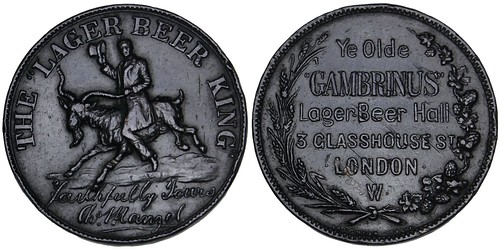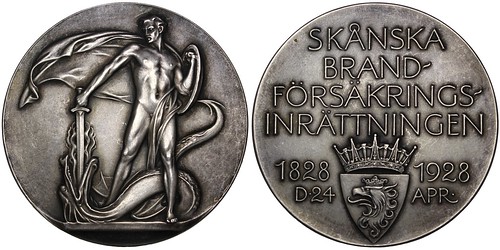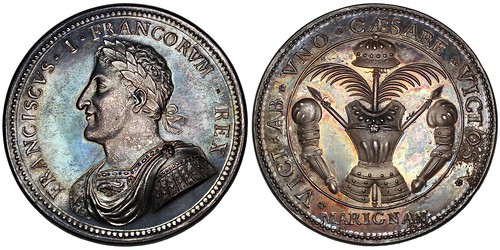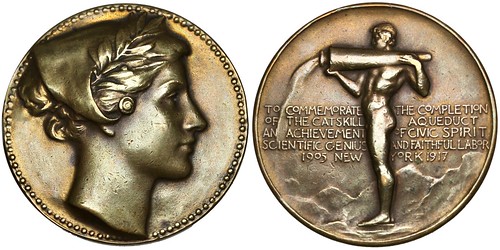
PREV ARTICLE
NEXT ARTICLE
FULL ISSUE
PREV FULL ISSUE
NUMISMAGRAM MEDAL SELECTIONS: JANUARY 2023Numismagram's Jeremy Bostwick sent along these four medals from his recent addition of new items to his website. For all of the new items, please visit https://www.numismagram.com/inventory. -Editor 101790 | GREAT BRITAIN. London. Gambrinus Restaurant bronze Token Issued circa 1890 for Charles Manzel's "Lager Beer Hall" in Piccadilly Circus (30mm, 10.56 g, 12h). By Vaughton's in Birmingham. THE "LAGER BEER KING", man in frock coat, riding goat left and removing top hat; in two lines below in script: "Faithfully Yours / Chs. Manzel" / Ye Olde / "GAMBRINUS" / Lager-Beer Hall / 3 GLASSHOUSE ST / LONDON / W in six lines; all within wreath of barley grains and hop cones. Edge: Plain. About Uncirculated Details. Dark brown surfaces, with a few lightly scattered scuffs and marks. A fairly scarce and interesting piece of breweriana. $95.
As the turn of the century approached near the end of the Victorian era, the timelier shipping of food and drink allowed for an increase in the presence of imported goods for the English consumer. While beer—in the form of ale—was no stranger at any public house, its crisper cousin—in the form of lager—was not nearly as present, given that the latter was far more frequently (and rather expertly) brewed in Germany, Austria, and Bohemia. Its highly regarded and refined status was a treat for the English pub drinker, so much so that pubs and restaurants specializing in the import and tapping of lager barrels began to pop up. This advertising token points to the popularity of the time, as the name of "The traveller's [sic] thirst can at all times be conveniently quenched at a Public House,, where a glass of bitter beer, ale, stout, or ‘half-and-half' (i. e. ale or beer, and stout or porter, mixed) is to be had for 1-1/2-2d [pence]. (6d. or 8d. per quart). Good German Lager Bier (3-6d. per glass) is now very generally obtainable at the larger restaurants, in some of which it has almost entirely supplanted the heavier English ales. Wine (not recommended) may also be obtained. Genuine Munich Beer, (‘Pschorr') and Bohemian Beer, (‘Bürgerliches Bräuhaus, Pilsen') from the cask may be obtained at the Gambrinus Restaurants, 3 Glasshouse Street, Piccadilly Circus, and 3 Lawrence Lane, Cheapside; also German sausages, smoked eel, and similar ‘whets'. English-made lager-beer is supplied in an establishment in the basement of the Café Monico, Piccadilly Circus, fitted up in the ‘old German' style."
To read the complete lot description, see:
102229 | SWEDEN. Skåne Fire Insurance Institute silver Medal. Issued 1928. Commemorating the 100th anniversary of the establishment (50mm, 51.75 g, 12h). By E. Lindberg in Stockholm. Male standing facing, head lowered left and nude except for billowing cape, thrusting sword into the mouth of a fire breathing dragon to lower left / SKÅNSKA / BRAND– / FÖRSÄKRINGS– / INRÄTTNINGEN in four lines; below, crowned civic coat-of-arms of Skåne between 1828 / D•24 – 1928 / APR•. Edge: SILVER 1928. Ehrensvärd 284. Mintage: 3 (in gold) & 250 (in silver). Gem Mint State. Slate gray surfaces, with some deeper toning nearer the peripheries and a great matte nature overall. $235.
To read the complete lot description, see:
102234 | FRANCE & SWITZERLAND. François I/Battle of Marignano silver Medal. Issued circa 1845-1860. Commemorating the victory over the Swiss (56mm, 74.27 g, 12h). After P. Regnier at the Paris mint. FRANCISCVS • I • FRANCORVM • REX, laureate, draped, and armored bust left / VICI • AB • VNO • CÆSARE • VICTOS • (I defeated the Helvetii, which only Julius Caesar had defeated before me) / MARIGNAN, trophy of arms, with spears and palm fronds. Edge: «hand» ARGENT. Cf. MdP 102/3; cf. SM 115 (bronze). Choice Mint State. Extremely lustrous and vibrant in the fields, with some hints of cobalt and burnished amber sprinkled throughout; a typical die flaw is noted on the obverse, and some very minor metal roughness in the last two letters of the reverse legend is noted for completeness. $465.
The last major conflict in the War of the League of Cambrai, the Battle of Marignano (now known as Melegnano) pitted François, the newly crowned king of France, against mercenaries of the Old Swiss Confederacy. The war was itself a part of a series of skirmishes known as the Italian wars—territorial issues that saw various factions both against and with others at differing times, including the Holy Roman Empire, the Papal States, the Republic of Venice, the Duchy of Milan, and Spain. Following the success of François and his French forces at Marignano, the Swiss cantons signed a treaty of
To read the complete lot description, see:
102343 | UNITED STATES. Catskill Aqueduct Completion bronze Medal/"so-called Dollar". Issued 1917 (38mm, 26.05 g, 12h). By D. C. French & A. Lukeman, and struck by the Medallic Art Co. in New York. Female head right, wearing laurel wreath and head scarf / Nude male standing left, pouring forth water from a large urn; in four lines across field, TO COMMEMORATE THE COMPLETION / OF THE CATSKILL AQUEDUCT / AN ACHIEVEMENT OF CIVIC SPIRIT / SCIENTIFIC GENIUS AND FAITHFUL LABOR / 1905 NEW YORK 1917. Edge: MEDALLIC ART CO NYC. HK 667; Marqusee 177; Baxter 245. Choice Extremely Fine. Light olive-brown surfaces. $345. Started in 1905, the Catskill Aqueduct—intended to transport water from the Catskill Mountains some 163 miles south to New York City—was completed 12 years later—an event that was to be commemorated on a medal authorized by the subcommittee of the Mayor's Catskill Aqueduct Celebration Committee. Daniel Chester French, who served on the board of trustees of the Metropolitan Museum of Art with Robert de Forest (himself the president of the aforementioned committee), was selected to design the commemorative medal. The subsequent work of art, issued by the American Numismatic Society (ANS), measured 76mm in diameter and was cast in both bronze and silver, with respective mintages of 57 and 12 in these formats. The Medallic Art Company (MACO), entirely independent of the ANS, struck an unknown number of medals with this design in bronze and at a diameter of 38mm. Sixteen years later, then president of MACO Clyde Curlee Trees chose French's obverse design—depicting a female representative of either Greater New York or Columbia—as the symbol and logo of MACO, with it becoming synonymous with the company going forward. Interestingly enough, the ANS is now the owner of the archival remains and intellectual property rights of MACO, the former having purchased the latter out of bankruptcy in 2018.
To read the complete lot description, see:
Wayne Homren, Editor The Numismatic Bibliomania Society is a non-profit organization promoting numismatic literature. See our web site at coinbooks.org. To submit items for publication in The E-Sylum, write to the Editor at this address: whomren@gmail.com To subscribe go to: https://my.binhost.com/lists/listinfo/esylum All Rights Reserved. NBS Home Page Contact the NBS webmaster 
|




